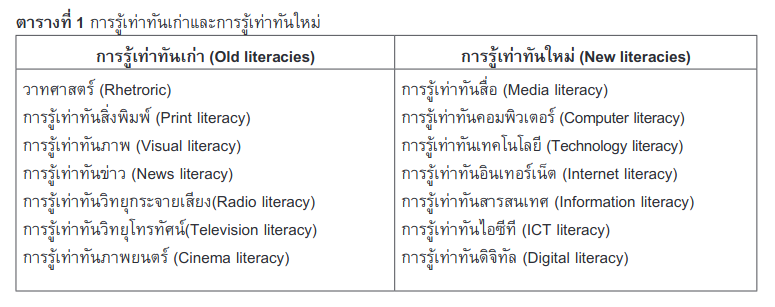การรู้เท่าทันดิจิทัล: วิวัฒนาการ ความหมาย และการสังเคราะห์ทักษะ
Main Article Content
บทคัดย่อ
การรู้เท่าทันดิจิทัลเป็นความสามารถของผู้ใช้งานเครื่องมือดิจิทัลทั้งฮาร์ดแวร์และซอฟต์แวร์เพื่อการศึกษา การทำงาน การหาความบันเทิง การสื่อสาร การมีส่วนร่วมในการสร้างสรรค์และผลิตเนื้อหาดิจิทัล ซึ่งผู้ใช้งานควรมีทักษะการคิดวิเคราะห์และการประเมินเนื้อหาดิจิทัลได้อย่างมีวิจารณญาณ ตลอดจนมีความรับผิดชอบและมีจริยธรรมต่อสังคมส่วนรวมภายใต้ระบบนิเวศดิจิทัล ดังนั้นเพื่อสร้างความเข้าใจเบื้องต้นที่ชัดเจน บทความนี้จึงมีวัตถุประสงค์เพื่ออธิบายวิวัฒนาการของการรู้เท่าทันดิจิทัล ความหมายของการรู้เท่าทันดิจิทัล และทักษะการรู้เท่าทันดิจิทัล ประกอบด้วย 7 ทักษะได้แก่ (1) ทักษะการเข้าถึง คือ ความสามารถในการเลือกและใช้เทคโนโลยีดิจิทัลได้อย่างเหมาะสม (2) ทักษะการวิเคราะห์ คือ ความสามารถในการอ่านและทำความเข้าใจสารสนเทศ และสัญลักษณ์ได้อย่างถูกต้อง (3) ทักษะการประเมิน คือ ความสามารถในการตัดสินคุณภาพ คุณประโยชน์ของสารสนเทศที่ได้จากแหล่งสารสนเทศที่หลากหลาย (4) ทักษะการสร้างสรรค์ คือ ความสามารถในการสร้างสารสนเทศด้วยเทคโนโลยีดิจิทัลอย่างมีประสิทธิภาพ (5) ทักษะการสื่อสาร คือ ความสามารถในการเลือกช่องทางการสื่อสารเนื้อหาดิจิทัล ไปยังกลุ่มเป้าหมายได้อย่างเหมาะสมภายใต้สิ่งแวดล้อมดิจิทัล (6) ทักษะการสะท้อนกลับ คือ ความสามารถในการแสดงความคิดเห็น การโต้ตอบและการเชื่อมโยงสารสนเทศไปยังบุคคลอื่น และ (7) ทักษะการปฏิบัติ คือ ความสามารถในการทำงานและการร่วมมือกับบุคคลอื่นในการแบ่งปันความรู้ และการแก้ปัญหาที่เป็นประโยชน์ต่อสังคมส่วนรวมได้อย่างเหมาะสม
Article Details

This work is licensed under a Creative Commons Attribution-NonCommercial-NoDerivatives 4.0 International License.
ผู้แต่งจะต้องกรอกข้อมูลเพื่อโอนลิขสิทธิ์ (copyright) ให้กับวารสารวิทยาการสารสนเทศและเทคโนโลยีประยุกต์ ก่อนเผยแพร่บทความ โดยดูรายละเอียดเพิ่มเติมได้ที่ https://ph01.tci-thaijo.org/index.php/jait/copyrightlicense
References
Anyangwe, E. (2012). 20 Ways of thinking about digital literacy in higher education [On-line]. Available: https://www.theguardian.com/higher-education-network/blog/2012
Belshaw, D. (2011). What is digital literacy? a pragmatic investigation. Ed.D. Dissertation, of Department of Education at Durham University.
British Film Institute. (2000). British film institute annual review 1 April 1999-31 March 2000 [On-line]. Available: https://www.bfi.org.uk/sites/bfi.org.uk/files/downloads/bfi-annual-review-1999-2000.pdf
Buckingham, D. (2006). Defining digital literacy : What do young people need to know about digital media?. Digital Kompetanse. 1: 263-276.
California Emerging Technology Fund. (2008). California ICT digital literacy policy framework. [On-line]. Available:https://ictliteracy.info/rf.pdf/california%20%20ICTPolicy%20Framework.pdf
Calvani, A., Fini, A. and Ranieri, M. (2009). Assessing digital competence in secondary education. Issues, models and instruments. In M. Leaning (ed.). Issues in information and media literacy: Education, practice and pedagogy. Informing Science Press (pp.153-172). California: Informing Science Press Publishing.
Covello, V. T. (2010). Strategies for overcoming challenges to effective risk communication. In R. J. Heath and H. D. O’Hir (ed.). Handbook of risk and crisis communication (pp. 143-167). New York: Routledge.
Fantin, M. and Grardello, G. (2008). Digital literacy and cultural mediations to the digital divide. In P.C. Rivoltella (ed.). Digital literacy: tools and methodologies for information society (pp.310-340). New York: IGI Publishing.
Hartley, S. (2011). Communication, cultural and media studies: the key concepts. 4th ed. Oxford: Routledge.
Hobbs, R. (2010). Digital and media literacy: a plan of action. Washington: The Aspen Institute Communications and Society Program.
Hobbs, R. and Moore, D. C. (2013). Discovering media literacy: teaching digital media and popular culture in elementary school. California: SAGE Publications.
Horton, F. W. (2007). Understanding information literacy: a prim. Paris: The United Nations Educational Scientific and Cultural Organization.
Jirasopol, P. (2017). Communication literacy in digital age and its role in guiding the direction of communication reform in Thai society.(In Thai). Bangkok : Communication Arts Faculty Dhurakij Pundit University.
Jutrakol, S. (2017). Digital literacy, digital natives and family. (In Thai). Journal of Management Science Chiangrai Rajabhat University. 11(1): 131-150.
Krutasean, U. (2013). The development of the media literacy learning process approach for the youth leader. (In Thai). Bangkok : Doctoral of Management Degree in Business Suan Dusit Rajabhat University.
Lankshear, C. and Knobel, M. (2006). New literacy: everyday practices and classroom learning. 2nd ed. Maidenhead: Open University Press.
Media Awareness Network. (2010). Digital and literacy [On-line]. Available: https://mediasmarts.ca/sites/mediasmarts/files/pdfs/publication-report/full/digitalliteracypaper.pdf
National Statistical Office. (2016). The use of information and communication technology in the household in 2016 [On-line]. (In Thai). Available:https://service.nso.go.th/nso/nsopublish/themes/files/icthh_exc_59.pdf
Punie, Y. and Redecker, C. (2012). Understanding digital competence in the 21st century: An analysis of current frameworks. Lecture Notes in Computer Science. 7563: 79-92.
Summey, D. C. (2013). Developing digital literacies a framework for professional learning. California: SAGE Publications.
United Nations Educational Scientific and Cultural Organization (UNESCO). (2011). Digital literacy in education [On-line]. Available: https://unesdoc.unesco.org/images/0021/002144/ 214485e.pdf
White, J. (2015). Digital literacy skills for FE teachers. London: SAGE Publications.





